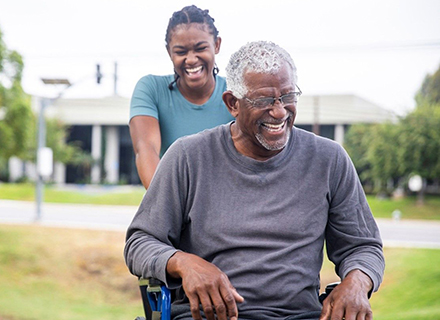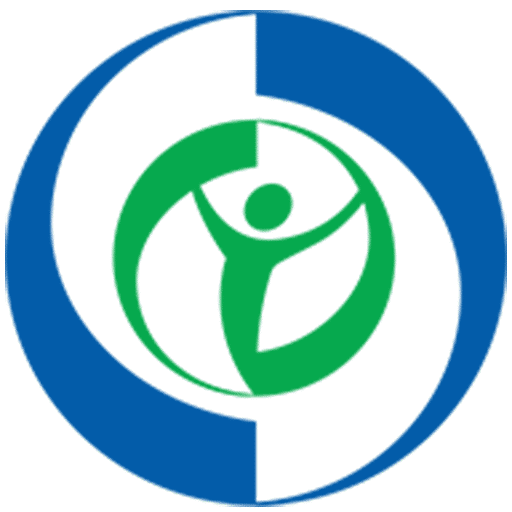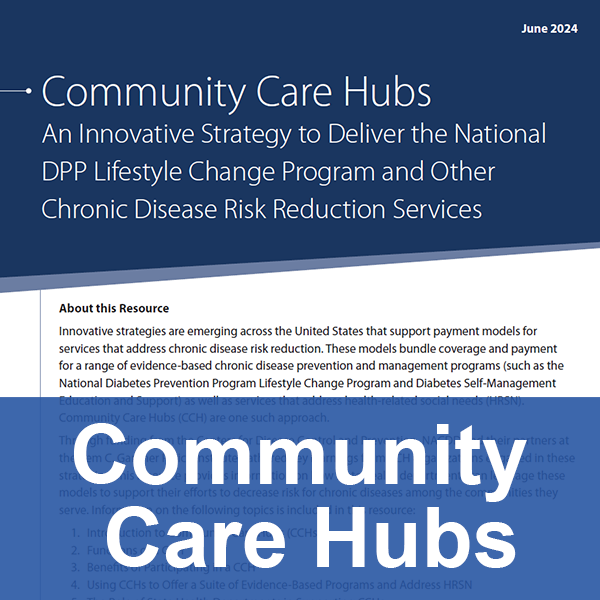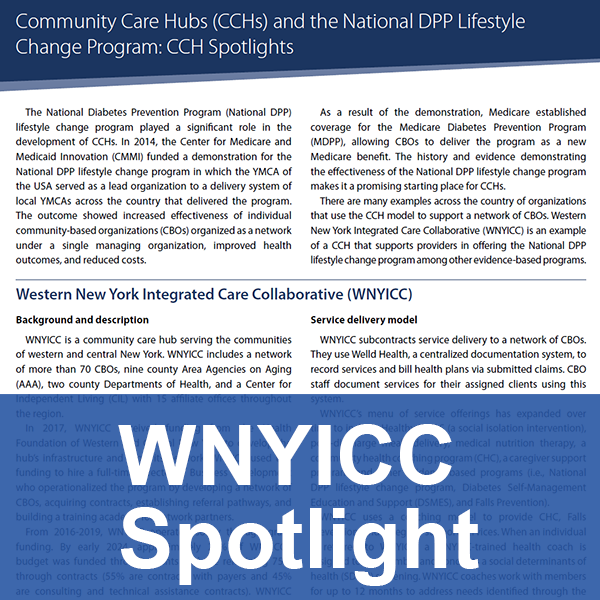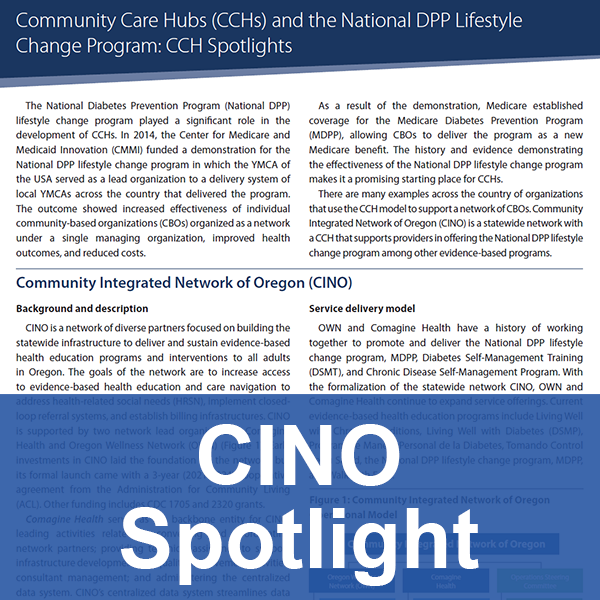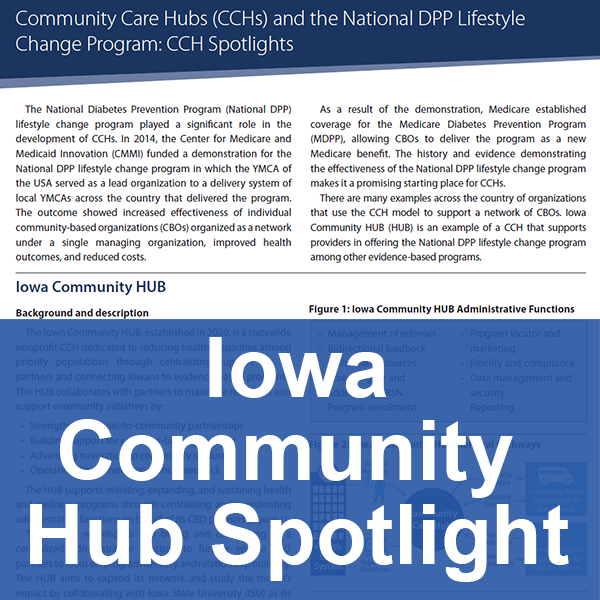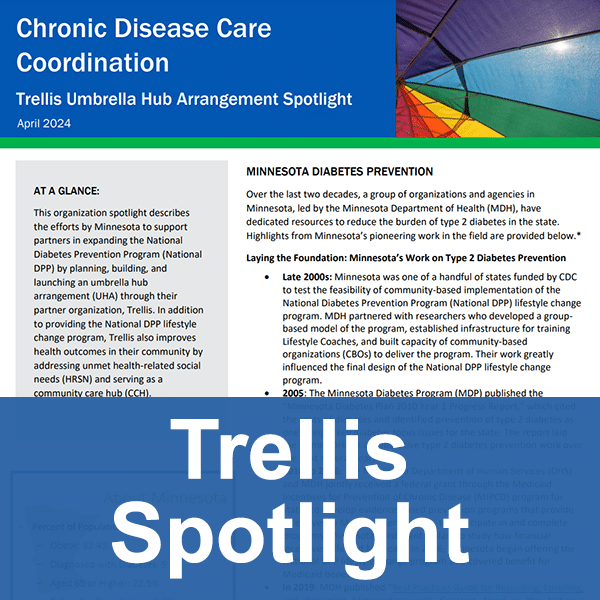Building Partnerships → Community Care Hubs
Community Care Hubs
It is increasingly common for community-based organizations (CBOs) to contract with a lead organization as part of a broader CBO network. This CBO network approach is based on the premise that when the different CBOs and health care organizations are coordinated and well-integrated, the individuals they collectively serve will experience better overall health and health outcomes. One such CBO network approach is the community care hub (CCH).
A CCH is a community-focused entity that organizes and supports a network of CBOs providing evidence-based chronic disease prevention and management programs and services to address health-related social needs (HRSN). A CCH supports their network through centralizing administrative functions and operational infrastructure. A CCH has trusted relationships with and understands the capacities of the local CBOs and health care organizations in their network and fosters cross-sector collaborations that incorporate authentic local voices through community-based leadership.
A CCH is a promising approach for how a group of organizations can work together to deliver and increase enrollment in the National Diabetes Prevention Program (National DPP) lifestyle change program. To watch the NACDD General Member Webinar from June 2024 on CCHs, please click below.
This page describes the following topics:
- Functions of a Community Care Hub
- Benefits of Participating in a Community Care Hub
- Using Community Care Hubs to Offer a Suite of Evidence-Based Programs and Address HRSN
- How is a Community Care Hub Different from Other CBO Network Approaches?
- Community Care Hub Spotlights
Functions of a Community Care Hub
A CCH supports their network members by centralizing administrative functions and operational infrastructure to support a range of evidence-based chronic disease prevention and management program delivery (e.g., National DPP lifestyle change program, Diabetes Self-Management Education and Support (DSMES), Diabetes Self-Management Program (DSMP), Medical Nutrition Therapy (MNT), Falls Prevention Program, etc.). Functions of a CCH include, but are not limited to:
- Leadership and governance of network members
- Strategic business development and contracting with health care organizations and payers
- Payment operations
- Management of referrals
- Service delivery fidelity and compliance
- Technology and information security
- Data collection and reporting
Benefits of Participating in a Community Care Hub
There are many ways organizations offering the National DPP lifestyle change program may benefit from participating in a CCH, including:
- Enhance System Efficiency: A CCH is essentially a one-stop shop for the delivery of multiple evidence-based programs, interventions, and services. It offers inherent efficiencies to scale contracting opportunities and to integrate health care and social care efforts. It allows health care organizations and health insurance companies to contract with multiple CBOs in a streamlined way and ensure the quality of services delivered. These entities may also be better equipped to provide continuity of services for individuals facing changes in insurance coverage, as is fairly common with Medicaid churn (individuals moving in and out of Medicaid eligibility or between MCOs or health plans due to changing financial status or other reasons). For more information on churn see the Reimbursement page of the Coverage Toolkit.
- Enhance System Efficiency: A CCH is essentially a one-stop shop for the delivery of multiple evidence-based programs, interventions, and services. It offers inherent efficiencies to scale contracting opportunities and to integrate health care and social care efforts. It allows health care organizations and health insurance companies to contract with multiple CBOs in a streamlined way and ensure the quality of services delivered.
- Expand CBO Capacity: A key element of CCHs is their diverse network of CBOs and health care organizations that cover broad geography, populations, and provide an increased set of services—which expands the capacity to address chronic disease prevention and management and HRSN beyond the capability of a single CBO.
- Advance Health Equity: CCHs and their CBO provider network are experts in delivering social care support and services that address HRSN. With the CCH providing administrative and operational support, CBOs in the network have increased capacity to focus their efforts on addressing the needs most prevalent in their communities. For many CBOs and health care organizations, this directly aligns with their organization’s health equity goals.
- Engage Communities: CCHs are made up of a diverse collection of CBOs who are trusted partners in the communities they serve and act as an important connection between health care and social care sectors. A CCH works with their network to build and/or strengthen trust with community members and gather feedback from a broad range of voices on important matters.
- Create Financial Benefits: CBOs participating in a CCH do so in part because they often lack the organizational capacity and resources to contract directly with health care organizations and health insurance companies. CCHs can provide valuable input and support to ensure appropriate and equitable payment rates are in place for CBOs. They can also help identify and/or leverage funding from additional federal, state, local, and private organizations. Health insurance companies and other payers seeking to reduce emergency department visits, hospital readmissions, and improve clinical outcomes can benefit from having CBOs with existing trusted relationships among community members. The CBOs can help lead payers’ efforts to address HRSN, resulting in a return on investment for the payers.
For organizations looking to strengthen their delivery of the National DPP lifestyle change program, participating in a CCH can increase their capacity to focus on the unique needs facing their priority populations, opening time and resources to implement strategies to increase enrollment and retention in the program.
Using Community Care Hubs to Offer a Suite of Evidence-Based Programs and Address HRSN
A CCH centralizes the delivery of multiple evidence-based programs and services. By engaging with a diverse network of CBOs, CCHs can provide individuals with access to an increased set of programs. This expands the CCH’s capacity to address chronic disease prevention and management beyond the capability of a single CBO.
Barriers to participating in evidence-based programs, including the National DPP lifestyle change program, are often the result of HRSN. HRSN are an individual’s or family’s unmet, adverse social conditions that can lead to decreased health and a lower quality of life (e.g., lack of transportation, housing instability, food insecurity). Social determinants of health (SDOH) are the conditions in the environment where people are born, live, learn, work, play, worship, and age that affect a wide range of health, functioning, and quality of life outcomes and risks. While everyone has socially determined factors of health, some populations and individuals may have HRSN stemming from these factors. Because HRSN can influence whether an individual enrolls, engages, and remains in programs like the National DPP lifestyle change program, CCHs highlight a promising opportunity to address these HRSN.
The Office of the Assistant Secretary for Planning and Evaluation (ASPE) issued a Call to Action in November 2023 that encourages partnerships across health care, social services, public and environmental health, government, and health information technology sectors to improve the health and well-being of every individual. It highlights the importance of CCHs in managing these partnerships and improving coordination between health and social care providers.
Research finds that CCHs improve the ability of CBOs to address HRSN. CCHs provide the vital connection within a community to ensure a coordinated approach to health and social care is working equitably to meet an individual’s needs. Through the establishment of a diverse network of CBOs providing multiple evidence-based chronic disease prevention and management programs, CCHs increase the efficiency and effectiveness of individual CBOs to address HRSN by expanding their geography, populations served, and the services they provide. The CBOs that make up a CCH have trusted relationships with the individuals and communities they serve and are experts in delivering social care services that address HRSN.
The National DPP lifestyle change program, for example, is uniquely positioned to address unmet HRSN among program participants. Visit the Addressing HRSN Through the National DPP Lifestyle Change Program page for more information on how the National DPP lifestyle change program teaches valuable skills that address HRSN, as well as opportunities to address HRSN to support participants’ success in the program.
Role of Public Health in Supporting Community Care Hubs
CCHs are important partners as state health departments seek to prevent chronic disease and expand access to services that address HRSN. The following resource, Community Care Hubs: An Innovative Strategy to Deliver the National DPP Lifestyle Change Program and Other Chronic Disease Risk Reduction Services, expands on the information found on this page and details how state health departments can leverage CCHs to support their efforts to decrease risk for chronic diseases among the communities they serve.
How is a Community Care Hub Different from Other CBO Network Approaches?
CCHs are one approach to building a CBO network. Two other CBO network approaches are umbrella hub arrangements (UHA) and the partner network. While these models also provide an overarching infrastructure aimed at centralizing administrative and operational functions for a collective group of CBOs, there are some differences worth noting. For example, a key differentiating factor of CCHs when compared to UHAs and partner networks is their focus on supporting CBOs in the delivery of multiple evidence-based programs compared to the delivery of only the National DPP lifestyle change program.
It is important to note that an organization can participate in more than one CBO network approach. For example, Trellis serves as an umbrella hub organization (UHO) to support organizations in delivering the National DPP lifestyle change program and is also recognized as a CCH providing a package of evidence-based programs and HRSN supports. The summary table below describes key components of CCHs, UHAs, and the partner network approach.
UHAs
UHAs connect CBOs with health care payment systems to pursue sustainable reimbursement for the National DPP lifestyle change program. UHOs administer and lead the arrangement. Startup funding for UHAs almost exclusively comes from CDC’s Division of Diabetes Translation (DDT). Submitting claims, and subsequently receiving health insurance reimbursement, is a critical component to sustaining any UHA.
Benefits unique to UHAs include the following:
- Operate as one Medicare Diabetes Prevention Program (MDPP) Supplier: In a UHA, the UHO is the MDPP enrolled supplier and subsidiary organizations do not separately enroll as MDPP suppliers.
- Share CDC-Recognition Status: To join a UHA, each subsidiary organization must have pending, preliminary, or full recognition; however, while participating in the arrangement, all subsidiary organizations assume the recognition status of the UHO.
- Streamline billing, claims, and administrative support: A key element of a UHA is a single billing and claims submission platform used by all subsidiary organizations.
Historically, the key differentiating factor of UHAs compared to CCHs and partner networks is UHAs solely focus on the National DPP lifestyle change program. However, some UHAs, such as the YMCA of Metropolitan Milwaukee, have subsequently become CCHs and begun to include other chronic disease programs in their network in addition to the National DPP lifestyle change program. The YMCA of Metropolitan Milwaukee’s other chronic disease programs include blood pressure self-monitoring, group exercise for older adults, support for cancer survivors, fall prevention, and weight loss and management.
See the UHA Overview page of the Coverage Toolkit for more information on UHAs.
Partner Networks
A partner network is a group of organizations and representatives from different communities that team up to advance a common goal or vision. Partners leverage each other’s expertise and reach to maximize their capacity and capabilities.
An example of a partner network in the context of type 2 diabetes prevention is the Bright Spot Initiative (BSI), which applies the principles of collective impact with the goal of dramatically increasing enrollment in the National DPP lifestyle change program. Collective impact is an engagement approach which consists of a multisectoral collaboration of organizations and community members that advance equity through shared learnings and integrated actions to achieve population and systems-level change. At its helm is a backbone organization that manages and coordinates the networks’ efforts towards successful implementation of collective impact. Similar to CCHs and UHAs, partner networks advance health equity by centering health equity strategies in all their activities.
A key differentiating factor of partner networks when compared to CCHs and UHAs is the partner networks’ efforts to leverage each partner’s unique expertise and reach to maximize their collective capacity to achieve the same agreed upon goal(s) (as opposed to the lead organization supporting the needs and goals of individual partner organizations). Another key difference is that partner networks could be formed in any industry. See the Partner Networks page of the Coverage Toolkit for more information.
| CCHs | UHAs | Partner Networks |
|
|
|
Community Care Hub Spotlights
The National DPP lifestyle change program played a significant role in the development of CCHs. In 2014, the Centers for Medicare and Medicaid Innovation (CMMI) funded a demonstration for the National DPP lifestyle change program in which the YMCA of the USA served as a lead organization to a delivery system of local YMCAs across the country to deliver the program. The outcome showed increased effectiveness of individual CBOs organized as a network under a single managing organization, improved health outcomes, and reduced costs. As a result of the demonstration, Medicare established coverage for the MDPP, allowing CBOs to deliver the program as a new Medicare benefit. Because of the history and evidence demonstrating the effectiveness of the National DPP lifestyle change program, it makes for a promising starting place for CCHs.
There are many examples across the country of organizations that use the CCH model to support a network of CBOs. Below are several examples of CCHs that support providers in offering the National DPP lifestyle change program among other evidence-based programs.
Western New York Integrated Care Collaborative
Western New York Integrated Care Collaborative (WNYICC) operates a CCH through a network of more than 70 CBOs, nine county Area Agencies on Aging (AAA), two county Departments of Health, and a Center for Independent Living (CIL) with 15 affiliate offices throughout the communities of western and central New York. WNYICC provides support for chronic care management, the National DPP lifestyle change program, a social isolation intervention, medical nutrition therapy, and other evidence-based programs. A coach is assigned to a referred member, conducts SDOH screening, and works with members for up to 12 months to address needs. For more information, see the WNYICC Spotlight.
Community Integrated Network of Oregon
The Community Integrated Network of Oregon (CINO) is a network of diverse partners focused on building the statewide infrastructure to deliver and sustain evidence-based health education programs and interventions to all adults in Oregon, including the National DPP lifestyle change program, Living Well with Chronic Conditions, Living Well with Diabetes (DSMP), Program de Manejo Personal de la Diabetes, Tomando Control de su Salud, MDPP, and Walk with Ease. Comagine Health and Oregon Wellness Network (OWN) participate as network lead organizations. For more information, see the CINO Spotlight.
Iowa Community Hub
The Iowa Community Hub is a CCH that supports a network of community partners in delivering evidence-based programs and supporting disease prevention. Hub navigators process referrals, screen individuals for HRSN, enroll them in the appropriate evidence-based program, and connect them to resources that address HRSN. For more information, see the Iowa Community Hub Spotlight.
Trellis
Trellis, an Area Agencies on Aging (AAA) and non-profit, serves as a UHO to support organizations in delivering the National DPP lifestyle change program. It is also recognized as a CCH and provides a package of evidence-based programs and HRSN supports; has contracts with payers across Minnesota; and can provide technology platforms, advertisements, marketing, and technical support to network partners. For more information, see the Trellis Spotlight.


